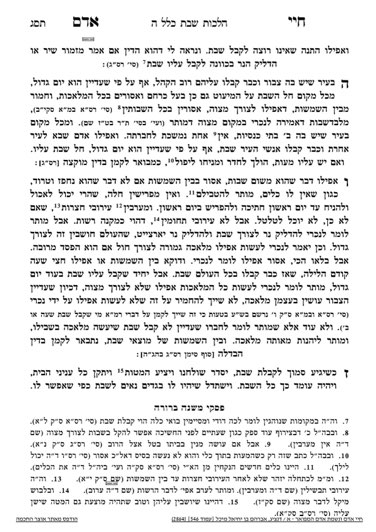We are beginning siman 7, which discusses the preparation of the home for Shabbos. The Chayei Adam writes that one should set their table and make the beds before accepting Shabbos. The Chayei Adam is referring primarily to the couches they would recline on when eating, but it applies to all beds in the house as well. Additionally, the house should look presentable. These preparations should be done in a way that they remain thus throughout Shabbos. Obviously, the house will be lived in throughout Shabbos, but one should strive to maintain a sense of tidiness throughout Shabbos.
A person should have nice clothing for Shabbos. If a person is traveling, and is the only Jew at a non-Jewish inn over Shabbos, they should still wear their special Shabbos garments. Apparently, people mistakenly thought that the reason to wear Shabbos clothing was so that when one is among other Jews, it does not appear as though they are denigrating Shabbos. Thus, the Chayei Adam stresses wearing Shabbos clothing even when one is not among Jews to correct this assumption. Rather, one wears special clothing in honor of Shabbos.
One should be excited about greeting Shabbos. The Gemara says that certain amoraim would physically walk out to invite the Shabbos, to concretize the idea that we are bringing Shabbos into our lives.
Some people would cover the challahs with the tablecloth, such that the challahs were between the table and tablecloth. The Chayei Adam writes that this is incorrect. The pasuk tells us that the man fell in the desert with a layer of dew underneath it and a layer above it. Since we eat lechem mishneh as a zecher to the man, one should make sure to have a covering underneath the challahs and on top as well.
The covering on top of the challah should remain until after kiddush, and the tablecloth should remain throughout Shabbos. The table should not be left bare.
It is interesting that the Chayei Adam writes that one can uncover the challahs after kiddush. The Mishnah Berurah discusses this point, and writes that there are other explanations as to why we keep the challahs covered. However, according to the explanation that it serves as a zecher to the man, it would be appropriate to keep the challahs covered until after one makes the bracha, in order to extend the zecher until one eats them.
The Chayei Adam continues, and writes that some communities have the minhag to make pastida (a knish) as a zecher to the man, because it also has a layer of dough on top and on bottom, and the food in between.
Summary
- One should set the table and prepare the house for Shabbos before lighting candles
- One should try to keep the house tidy throughout Shabbos
- The Challahs should be covered with a tablecloth underneath and a cover one top, as a zecher for the man. The top cover should remain until after the bracha of hamotzi.



